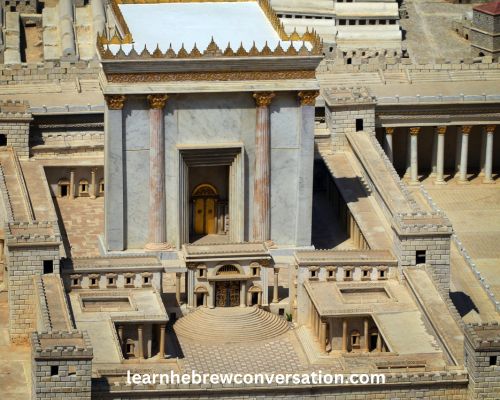The Holy of Holies, known in Hebrew as the “Kodesh HaKodashim,” was the innermost and most sacred area of the ancient Tabernacle and later the First and Second Temples in Jerusalem.

Location of Holy of The Holies
The Holy of Holies was situated at the westernmost end of the Tabernacle and Temple, beyond the Holy Place. It was separated from the rest of the sanctuary by a veil, known as the Parochet.
The central feature of the Holy of Holies was the Ark of the Covenant. The Ark contained the two stone tablets of the Ten Commandments, and some say also Aaron’s rod, and a pot of manna. The lid of the Ark, called the Mercy Seat, was flanked by two golden cherubim.
In Solomon’s Temple, the Holy of Holies was a perfect cube, measuring 20 cubits (approximately 30 feet) on each side. The Second Temple’s Holy of Holies had similar dimensions but lacked the Ark, which had disappeared by that time.
Significance
The Holy of Holies was considered the earthly dwelling place of God’s presence (Shekinah שכינה). It was where God’s presence was most intensely felt, making it the most sacred site in Judaism.
On Yom Kippur, the Day of Atonement, only the High Priest could enter the Holy of Holies, and only once a year . On this day, the High Priest would perform rituals to atone for the sins of the people, sprinkling the blood of a sacrificial animal on the Mercy Seat.
Some say there’s resemblance between the holy of holies and the garden of Eden.
In the midst of the Garden of Eden stands the Tree of Life. After the sin of Adam and Eve, the Tree of Knowledge was placed there, and at its entrance, cherubim were stationed to guard against human entry. Similarly, at the heart of the Holy of Holies, the Ark of the Covenant stands. Within it reside the Tablets of the Covenant and the Torah scroll, known as the ‘Tree of Life.’ Above it, two cherubim are positioned, and it is forbidden for anyone to enter there except the High Priest on Yom Kippur, following atonement and purification from sin.
Historical Timeline and Religious Context
- Solomon’s Temple: Built in the 10th century BCE, Solomon’s Temple was the first to house the Holy of Holies. The Ark of the Covenant was placed there, and the Temple became the center of Jewish worship.
- Destruction and Reconstruction: The First Temple was destroyed by the Babylonians in 586 BCE, leading to the loss of the Ark. The Second Temple, built in the 6th century BCE and later renovated by Herod the Great- הוֹרדוֹס, also featured a Holy of Holies but without the Ark.
- Second Temple Period: During this period, the Holy of Holies remained a focal point of Jewish worship despite the absence of the Ark. It continued to be the site of the High Priest’s annual entrance on Yom Kippur.
- Roman Destruction: The Second Temple was destroyed by the Romans in 70 CE, ending the era of the Holy of Holies as a physical space. Its destruction is commemorated by Jews on Tisha B’Av, a day of mourning and fasting.
Modern Significance
The location of the former Holy of Holies is believed to be on the Temple Mount in Jerusalem. This site remains a focal point of Jewish prayer and yearning, particularly for the rebuilding of the Temple.
